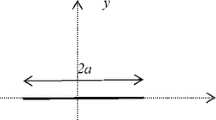Abstract
This paper is concerned with a numerical simulation of growth of fatigue cracks in a three-dimensional geometry. A continuous distribution of infinitesimal dislocation loops is employed to model the crack faces, so that the crack problem can be formulated as a set of singular integral equations. A numerical procedure based on an analytical treatment of the associated finite part integral is developed to solve the singular integral equations. The Paris law is then used to predict the rate of crack growth, so that the evolution of the crack shape under fatigue can be traced by a step-by-step algorithm. Various crack growth problems, e.g., the growth of a subsurface crack in a surface treated specimen, are analyzed using the technique, providing new data for several cracks of practical interest.
Similar content being viewed by others
Author information
Authors and Affiliations
Rights and permissions
About this article
Cite this article
Dai, D., Hills, D. & Nowell, D. Modelling of growth of three-dimensional cracks by a continuous distribution of dislocation loops. Computational Mechanics 19, 538–544 (1997). https://doi.org/10.1007/s004660050206
Issue Date:
DOI: https://doi.org/10.1007/s004660050206




